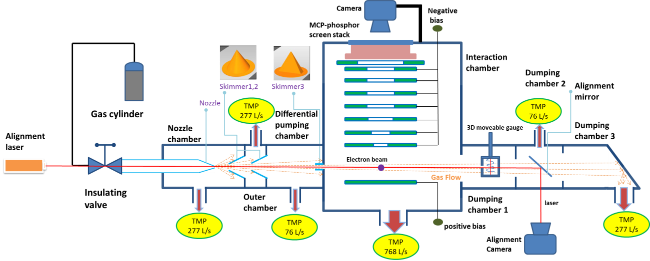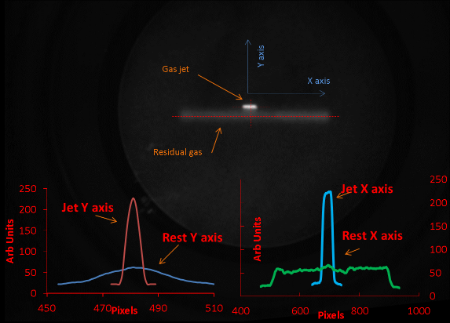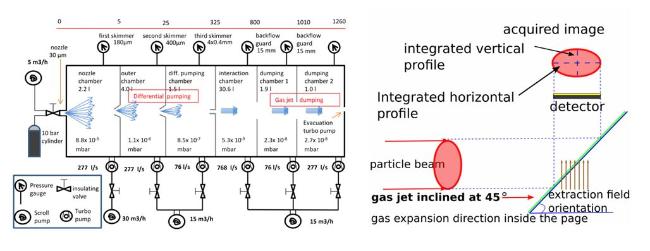Gas Jet Monitor
Profile monitors using gas ionisation or fluorescence have been used at a number of accelerators. They allow the transverse beam profile to be measured with minimal disturbance to the beam.

Typically, extra gas must be injected at the monitor which leads to a rise in pressure in the surrounding beam pipe. In contrast, a gas jet can be fired across the beam into a receiving chamber which limits the amount of gas escaping into the rest of the beam pipe. This is a considerable advantage since, as well as limiting the adverse effect on the beam lifetime and preserving the vacuum, it allows a higher gas pressure within the monitor and consequently a faster profile measurement. In addition, a gas jet shaped into a thin tilted plane can be used like a screen on which the beam cross-section is imaged. This is a considerable improvement to traditional ionisation monitors, which require separate monitors to measure the horizontal and vertical profile. For the production of a thin gas curtain, a series of skimmers and chambers differentially pumped are required.
The first results of the Quasar group’s prototype monitor were obtained in 2013 at the Cockcroft institute using the experimental setup which was developed there. Since then, the monitor has been constantly improving and has been equipped with new features such as a pulsed valve for further reduction of the gas load during operation.

Research is also ongoing regarding the diagnostics of the jet properties. The two methods currently being investigated are: 1) a laser based velocimeter for the measurement of the gas jet velocity and density, and 2) an ionization gauge based system mounted on a 3D scanning manipulator that could measure the inner gas jet’s pressure and visualize the 3D structure of the gas curtain. The ionization gauge based solution allowed us to probe and measure the 2D distribution of the gas jet curtain.
A hollow electron lens is currently being designed and developed at CERN in preparation for HL-LHC. In this experiment, a hollow electron beam co-propagates with the hadron beam. A non-invasive beam profile monitor capable of operating at high energies is needed to carefully observe the overlapping of both beams. Liverpool University, in collaboration with CERN and GSI, was recently commissioned to build and test a second gas-jet beam profile monitor in preparation for the implementation of the final design for the electron lens project.
The second gas-jet monitor has already been built in Cockcroft institute where various tests are being taken place with Nitrogen gas and Neon gas. A new electron gun with maximum current of 12 mA was purchased to be used in the interaction chamber. Stronger pumps, smaller interaction chamber and differential pumping stages have been implemented in the second setup to reduce the vacuum pressure to levels compatible with LHC. A new camera system has also been specifically designed for this setup to look at the beam induced fluorene in the gas jet. Schematics of the second setup along with a picture of the collected photons from the gas jet compared to the residual gas are displayed below. The information gathered from the two gas-jet setups will be carefully analysed to design a final gas-jet based beam profile monitor for the LHC.

The potential applications of gas jet based beam profile monitors span a large range of beam energies and meet the demanding criteria of many future accelerator facilities. As well as beam diagnostics purposes the apparatus can also be used in atomic physics experiments taking advantage of the ultra-cold supersonic gas jet produced. Another application area of a gas jet curtain is for the production of high charge states heavy ions beams in research centres like GSI and RIKEN.
Currently involved QUASARs:
Hao, Narender, Oliver, Catherine, William, Carsten
Selected Publications:
H. D. Zhang, E. Martin, V. Tzoganis, C. P. Welsch, N. S. Chritin, E. B. Diaz, O. R. Jones, G. Schneider, R. Veness, P. Forck, S. Udrea, ‘A supersonic gas jet-based beam induced fluorescence prototype monitor for transverse profile determination’, Proceedings of IPAC2017, Copenhagen, Denmark (2017) (MOPAB139)
V. Tzoganis, H. D. Zhang, A. Jeff, C. P. Welsch, ‘Design and first operation of a supersonic gas jet-based beam profile monitor’, Physical Review Accelerators and Beams 20 (6) (2017) (062801)
H. D. Zhang, V. Tzoganis, K. Widmann, C. Welsch, ‘3D density scans of a supersonic gas jet for beam profile monitor’, Proceedings of IBIC2016, Barcelona, Spain (2016) (WEPG71)
V.Tzoganis, A. Jeff, C.P. Welsch, 'Gas dynamics considerations in a non-invasive profile monitor for charged particle beams', VACUUM, DOI 10.1016/j.vacuum.2014.07.009 (2014) (S0042207X14002450)
V. Tzoganis, C. P. Welsch, 'A non-invasive beam profile monitor for charged particle beams', Applied Physics Letters 104, 204104 (2014) (1.4879285)
A. Jeff, V. Tzoganis, C.P. Welsch, 'A Gas-Jet Profile Monitor for the CLIC Drive Beam', IBIC 2013, Oxford, UK (2013)
M. Putignano, C. P. Welsch, 'Numerical study on the generation of a planar supersonic gas-jet', Nucl Instrum Methods Phys Res A 667 44-52 (2012) (S0168900211020961)
M. Putignano, K.-U. Kühnel, C.-D. Schröter, C. P. Welsch, 'A fast, low perturbation ionization beam profile monitor based on a gas-jet curtain for the ultra low energy storage ring', Hyperfine Interactions, In Press, 2009, :1-5 Language: English. DOI: 10.1007/s10751-009-0049-y
